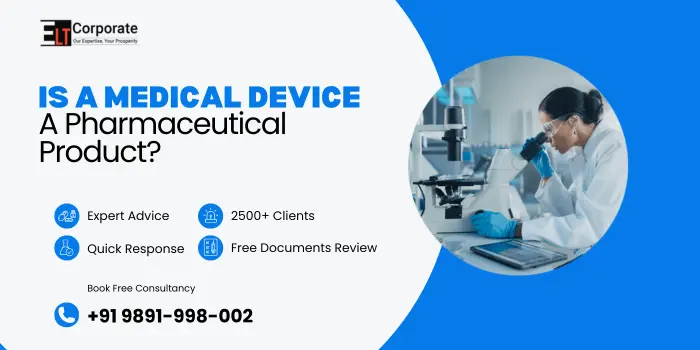The question “Is a medical device a pharmaceutical product?” is often confusing for manufacturers, importers, and even healthcare professionals. While both medical devices and pharmaceutical products aim to improve human health, they are very different in their definition, mode of action, regulations, and approval process. In India, these differences are very important because they decide which law applies, which authority regulates the product, and what approvals are required before sale or import. Below, we answer common questions in detail to make the distinction clear.
What Is A Medical Device As Per Indian And Global Regulations?
In India, the Medical Device Rules, 2017, under the Drugs and Cosmetics Act, define a medical device as any instrument, apparatus, implant, in-vitro reagent, software, or material intended to diagnose, prevent, monitor, treat, or support life but does not achieve its action through pharmacological, immunological, or metabolic means.
Globally, the definition is similar:
- WHO defines medical devices as products used in healthcare for diagnosis, prevention, or treatment without chemical action.
- US FDA and EU MDR also stress that medical devices act physically or mechanically, not chemically.
What Is A Pharmaceutical Product, And How Is It Different From A Device?
A pharmaceutical product (drug/medicine) is any substance used to diagnose, cure, treat, or prevent disease through chemical or biological action inside the body. Examples include tablets, vaccines, and antibiotics.
Unlike devices, pharmaceuticals rely on pharmacological or metabolic action. For example:
- Paracetamol reduces fever by acting on the body’s biochemistry.
- Antibiotics kill or stop the growth of bacteria.
In short:
- Medical devices work physically (like pacemakers or stents).
- Pharmaceuticals work chemically or biologically (like tablets or injections).
Is A Medical Device Considered A Pharmaceutical Product?
No, a medical device is not a pharmaceutical product. Both belong to the healthcare sector, but they are governed by different laws and regulated differently. In India, CDSCO regulates both, but devices fall under the Medical Device Rules, 2017, while pharmaceuticals are regulated under the Drugs and Cosmetics Act, 1940.
What Are The Key Differences Between Medical Devices And Pharmaceutical Products?
| Basis | Medical Devices | Pharmaceutical Products |
|---|---|---|
| Mode of Action | Physical or mechanical | Chemical, biological, or metabolic |
| Examples | Stents, pacemakers, syringes | Antibiotics, vaccines, tablets |
| Indian Law | Medical Device Rules, 2017 | Drugs & Cosmetics Act, 1940 |
| Regulators | CDSCO – Medical Device Division | CDSCO – Drugs Division |
| Testing | Biocompatibility, safety testing | Clinical trials, bioequivalence |
How Does The Mode Of Action Separate Medical Devices From Pharmaceutical Products?
The mode of action is the biggest difference:
- Medical devices work mechanically or physically. Example: A pacemaker regulates heartbeat through electrical pulses.
- Pharmaceuticals act through chemical or biological processes. Example: Insulin regulates blood sugar by affecting metabolism.
This distinction is the first step regulators use to classify a product.
Which Authority Regulates Medical Devices In India, And Which One Regulates Pharmaceuticals?
In India:
- Medical Devices are regulated by the CDSCO (Central Drugs Standard Control Organization) under the Ministry of Health and Family Welfare.
- Pharmaceutical Products are also regulated by CDSCO but under Drugs and Cosmetics Act, 1940.
So, the same authority (CDSCO) regulates both, but through different divisions and rules.
Are Medical Devices And Pharmaceuticals Covered Under The Same Laws In India?
No. They are regulated under separate frameworks:
- Medical Devices → Medical Device Rules, 2017
- Pharmaceuticals → Drugs and Cosmetics Act, 1940
However, since both relate to health, CDSCO ensures smooth coordination between them.
Can A Product Be Both A Medical Device A Pharmaceutical Product?
Yes, in some cases. A few products can fall into both categories depending on their composition and function.
Example:
- Drug-coated stents → The stent is a device, but the drug coating is pharmaceutical.
- Inhalers → The device delivers the medicine, so it is a combination product.
How Are Combination Products (Device + Drug) Regulated In India?
Combination products are regulated based on their primary mode of action:
- If the main function is physical → regulated as a medical device.
- If the main function is chemical/biological → regulated as a pharmaceutical product.
For example:
- Drug-eluting stents are classified as medical devices because their main role is mechanical support.
Why Is It Important To Distinguish Between A Medical Device And A Pharmaceutical Product?
Proper classification is important because it:
- Ensures compliance with the right laws.
- Helps manufacturers get correct approvals.
- Avoids delays, penalties, and recalls.
- Builds buyer trust in international markets.
What Are Some Real-Life Examples Of Medical Devices And Pharmaceutical Products?
- Medical Devices: Pacemakers, hearing aids, contact lenses, X-ray machines.
- Pharmaceutical Products: Painkillers, antibiotics, vaccines, insulin.
These examples clearly show the difference in mode of action and regulation.
How Does Correct Classification Help Manufacturers And Importers In India?
Correct classification helps by:
- Reducing regulatory risk.
- Making approval faster.
- Ensuring product safety and trust.
- Helping in global exports since international rules require proper classification.
Is An Fssai License Required For Medical Devices?
No, FSSAI licenses apply to food products, not medical devices.
Can A Medical Device Company Also Sell Pharmaceutical Products?
Yes, but they must get separate approvals under both device and drug regulations.


Comments are closed